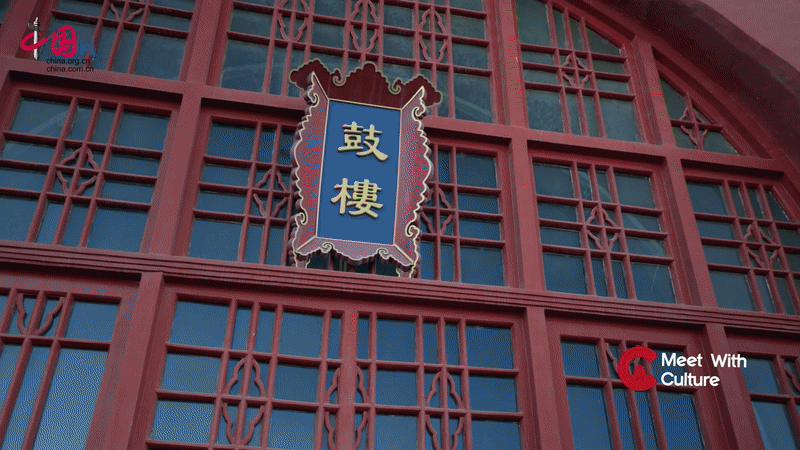We will stay firmly rooted in Chinese culture. We will collect and refine the defining symbols and best elements of Chinese culture and showcase them to the world. We will accelerate the development of China’s discourse and narrative systems, better tell China’s stories, make China’s voice heard, and present a China that is credible, appealing, and respectable.
Meet With Culture | Bell and Drum Towers: Timeless Sound of the Ancient Capital
发布时间:2024-12-16 09:05:03 | 来源:中国网-中国习观 | 作者: | 责任编辑:曹川川

The Bell and Drum Towers, as the time-announcing facilities in the Yuan (1271-1368), Ming (1368-1644) and Qing (1644-1911) dynasties, were symbols of royal dignity and authority. Overcenturies, the Bell Tower in the north and the DrumTower in the south had produced sound echoing around the city, guiding the work and rest of ordinary people and leading the developmentof the entire empire.

"The Drum Tower in the front features red walls and a yellow-tiled roof, and the Bell Tower features grey walls and a green-tiled roof. The Drum Tower is stout, and the Bell Tower is slim." This is how Chinese writer Liu Xinwu described the two landmarks of Beijing Central Axis in his novel The Bell and Drum Towers.

The Bell Tower was first built in 1272, the ninth year of the Zhiyuan reign of the Yuan Dynasty. From then on, the Bell and Drum Towers had undertaken the task to tell the time as part of the state apparatus. Later, they were burned down and reconstructed several times. The existing Drum Tower was built in the Ming Dynasty, and the existing Bell Tower built in the Qing Dynasty.
Ancient Chinese divided a day into 12 shichen (two-hour periods) and a night into five geng (each geng also equals to two hours). The geng starting at 7 p.m. is called the first or initial geng, and the second, third, fourth and fifth geng start at 9 p.m., 11 p.m., 1 a.m. and 3 a.m., respectively. The moment 5 a.m. is called "bright geng," which means daybreak.

Within over 600 years of time-announcing history, the Bell and Drum Towers in Beijing have always followed the routine of striking the drum followed by striking the bell. However, to avoid disturbing nearby residents at night, the Bell and Drum Towers only rang the bell and didn't beat the drum from the second to the fifth geng. When the "bright geng" arrived, operators beat the drum first and then rang the bell to tell the residents that it was already dawn. This is the origin of the idiom "morning bell and evening drum."
After daybreak, the city of Beijing becomes bustling, with the cries of hawkers reverberating in the air.
As for the number of stair steps, nine is the largest yang number in Chinese culture, which was exclusive to emperors in ancient China, symbolizing their supreme authority. Six is the median of the yin numbers. Here, it represents the 60-year circle.

Originally, there were 25 drums on the second floor of the Drum Tower, including one main drum and 24 subsidiary drums. The main drum symbolized the year, and the 24 subsidiary drums symbolized the 24 Solar Terms.
Ancient Chinese divided each year into 72 pentads, 12 months, and 24 Solar Terms. The sum of the three numbers is 108, which represents the circle of a year and symbolizes eternity. For this reason, the drums and bells were struck 18 times in quick, slow and medium rhythms in succession, twice, making the total strikes add up to 108.
About 100 meters north of the Drum Tower is the Bell Tower. Compared to the Drum Tower, the Bell Tower boasts a simple but practical architectural style. The bronze bell on the second floor of the Bell Tower is 5.55 meters tall and 63 tons heavy.

When constructing the Bell Tower, ancient Chinese built the bell first and then the tower. Artisans piled up two earth slopes as tall as the tower on both sides, along which they dragged the giant bell up. After the bell was installed, they removed the earth slopes, and used the two U-shaped locks to fix the top of the bell.
The internal structure of the Bell Tower incorporates a skylight, sound channel, and microphone facility, enhancing the functions of sound resonance, amplification, and transmission. When struck, the bell produces a sound reaching 110 decibels. Without obstruction from high-rise buildings, this sound could be clearly heard along the 7.8-kilometer Central Axis of Beijing. In ancient times, the bell's chimes signaled the closing of the nine gates of the outer city and the four gates of the imperial city, while night watchmen patrolled the streets, striking gongs and clappers to announce the time.

The beauty of the Bell and Drum Towers lies not only in the ancient buildings themselves, but also in the gentle and unblocked skyline nearby. The lofty buildings of the Bell and Drum Towers and their magnificent bases set off and complement each other with nearly ancient architectures, composing the multi-faceted, colorful but coordinated look of old Beijing. It is the extensive parallel space that makes the sound of the bell and drum continue reverberating for centuries and usher in a brighter future.
(Executive Producer: Wang Xiaohui; Production Supervisor: Xue Lisheng; Line Producer: Yu Li; Chief Planner: Ding Suyun, Cao Chuanchuan; Planner: Li Ying; Translator: Liu Haile)

